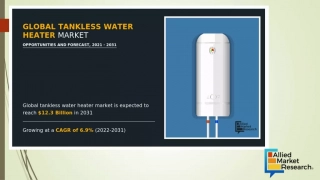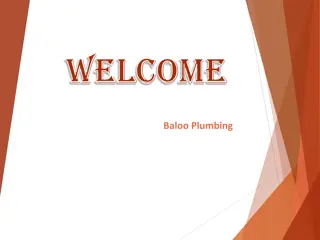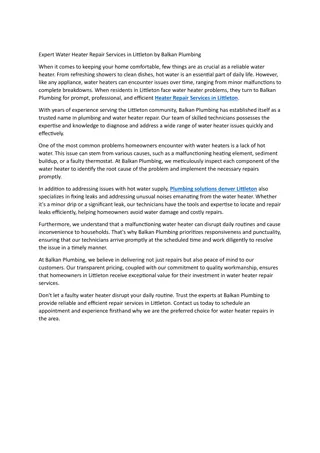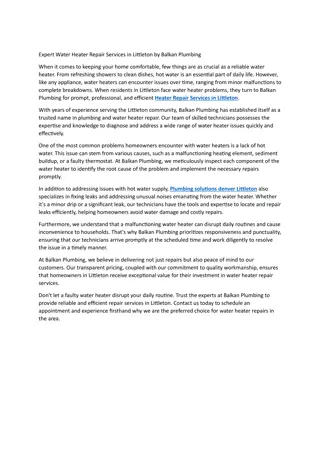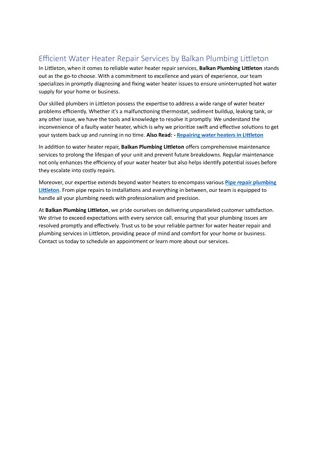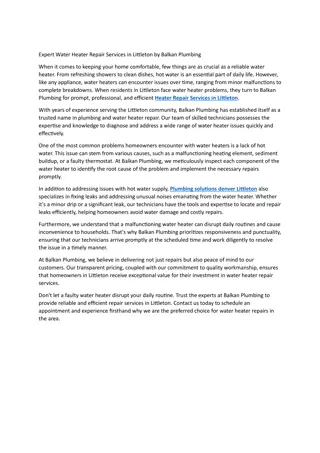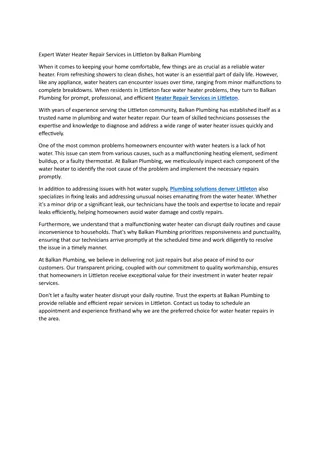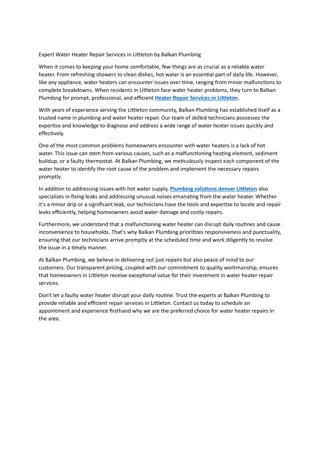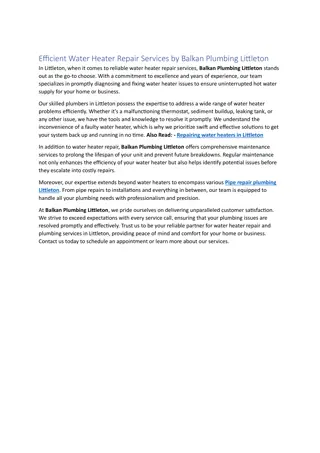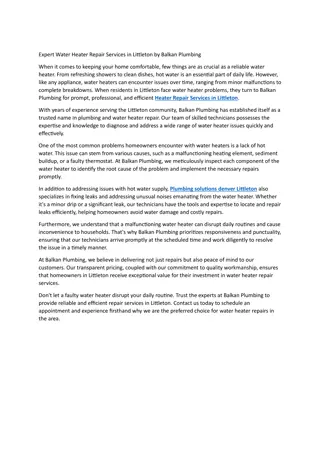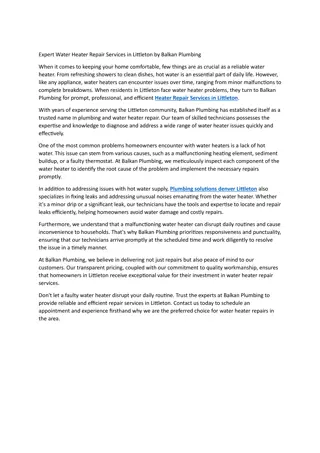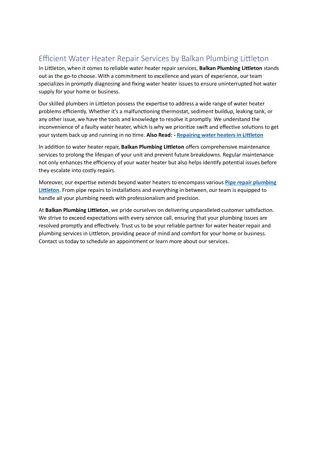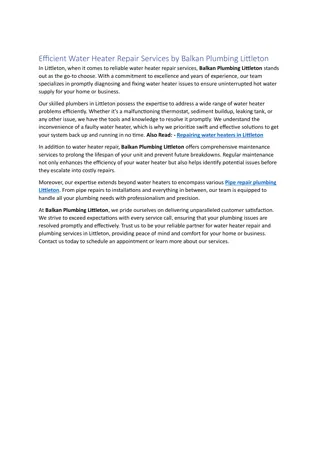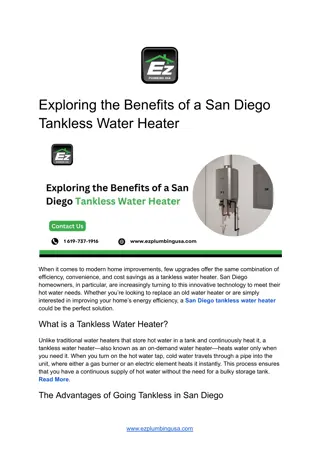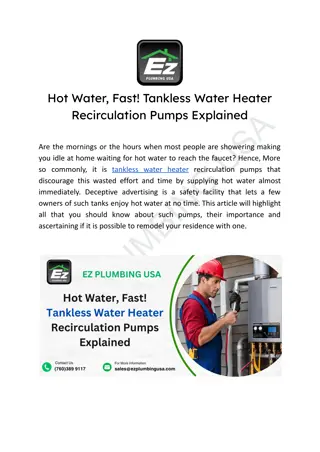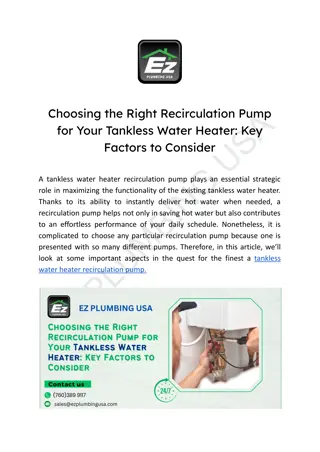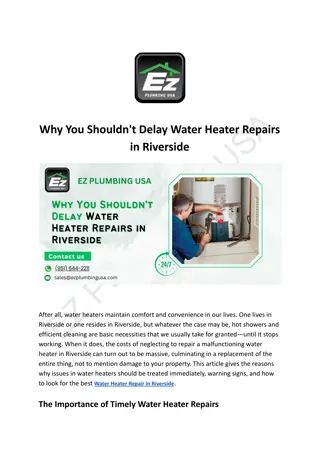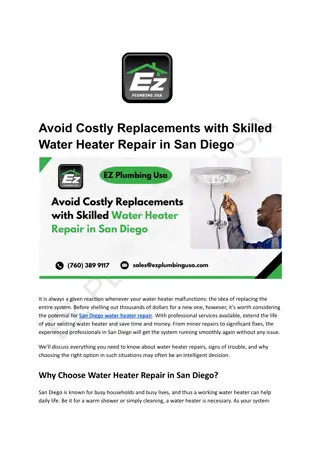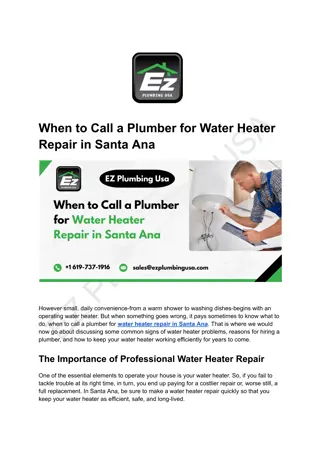
Clean Tankless Water Heater A Step-by-Step Guide - All Star Plumbing
Cleaning and maintaining the water heater is essential for longevity and efficient operation. Many factors affect its performance. Regular users of hot water tanks need to keep up with the maintenance checks and measures to catch any problems quickly
Download Presentation

Please find below an Image/Link to download the presentation.
The content on the website is provided AS IS for your information and personal use only. It may not be sold, licensed, or shared on other websites without obtaining consent from the author. Download presentation by click this link. If you encounter any issues during the download, it is possible that the publisher has removed the file from their server.
E N D
Presentation Transcript
Clean Tankless Water Heaters: A Step- by-Step Guide Cleaning and maintaining the water heater is essential for longevity and efficient operation. Many factors affect its performance. Regular users of hot water tanks need to keep up with the maintenance checks and measures to catch any problems quickly. It also avoids costly repairs. So, don t take hot water for granted! A consistent hot water supply is guaranteed only if a regular maintenance schedule is followed. The given article is a step-by-step guide on cleaning your water heater. Some of the instructions also apply to how to clean tankless water heaters. Follow them to ensure the efficiency and durability of your water heater. Tools Needed For Water Heater Maintenance The right tools and their use are essential for safe and efficient hot water tank cleaning. Here are the tools one would require- A garden hose drains the tank and directs the wastewater to an appropriate drainage location. www.allstarplumbingservice.com
The bucket collects any water or sediment that spills during the cleaning process. It is to maintain cleanliness. A screwdriver can be used to access or remove components of the water heater, including panels and anode rods. Gloves protect hands from hot water or sharp edges inside the tank and also prevent dirt and debris from entering. Goggles or protective masks protect the eyes and face from splashes or debris. They are especially important when using pressurized systems. Tankless Water Heater Cleaning Kit The right tools and their use are essential for safe and efficient hot water tank cleaning. Here are the tools one would require Descaling Solution: A descaling solution tailored to remove mineral deposits efficiently is included. Flushing Kit: The kit comprises hoses, connectors, and a pump to facilitate the system s thorough flushing. Cleaning Tool: It contains a brush or cleaning tool designed to remove debris and sediment buildup from components. The kit provides comprehensive instructions for proper use, ensuring effective maintenance. Steps to Clean Your Water Heater Prerequisite for Starting with Cleaning a Water Heater- www.allstarplumbingservice.com
1. Safety First: Before working on your water heater, taking precautions is of utmost importance. Start by switching off the water heater. It prevents electrical accidents. In the case of gas heaters, cut off the gas supply. It is essential to wear safety goggles, gloves, and a mask to protect against any direct contact with a potential hazard. 2. Gather Your Tools and Materials Prepping is key! All essential tools and materials collected beforehand make the cleaning process faster. Fundamental items placed handy help effectively carry out the maintenance tasks and ensure thorough cleaning of the water heater. www.allstarplumbingservice.com
3. Drain the Tank Draining the tank is crucial to getting rid of the sediment and debris accumulated at its bottom. This buildup compromises the heating efficiency. Start by connecting the garden hose to the drain valve at the base of the water heater tank. Make sure the connection is tight enough to prevent leaks during draining. Direct the other end of the garden hose somewhere the water can safely flow away. You may route the free end towards a floor drain or an outdoor location so that the water can flow away safely without any mess. In the tankless water heater cleaning procedure, descale the inlet filter to remove mineral buildup, clean the inlet filter and inspect the venting system for blockages. Open the drain valve to begin flushing the tank. This will expel the debris and built-up sediments along with the draining water, allowing thorough cleaning of the tank. During the draining process, monitor that the flushing occurs smoothly without any issues. Check the hose position and troubleshoot any drainage problems. After the tank is fully drained, close the drain valve. 4. Flush the Tank After draining, close the drain valve and refill the tank with cold water. Keep draining until the water runs clear. As the water becomes clear, it ensures the debris is removed. 5. Inspect the Anode Rod www.allstarplumbingservice.com
The anode rod needs to be checked from the inside. Inspect it for corrosion or signs of wear and tear. If the damage is significant, replace the anode rod. Timely replacement contributed to the increased lifespan of the water heating system. Routine check-ups help ensure optimal performance and longevity of the water heater. 6. Clean the Tank Exterior Clean the tank s exterior surfaces, too, as it is empty. Using a damp cloth or sponge to remove dirt is a simple, proactive maintenance step that improves the water heater s appearance. It also prevents corrosion. Regularly monitoring these tasks enhances the lifespan and efficiency of the water heater. 7. Check the Pressure Relief Valve The pressure relief valve is an important safety feature. It prevents the overpressurization of the tank. Routine check-ups include gently lifting the lever and checking if the air or water escapes. If any air or water is escaping, it means the valve is all right. If there is any leakage without opening the valve, it should be replaced as early as possible to maintain safety. Ignoring such issues could be hazardous, leading to tank explosions. This is why regular inspection and maintenance are vital. 8. Clean the Tank Exterior The final checking includes refilling the tank for any leaks. As cleaning and inspection are completed, close the drain valve and remove the hose. Now, fill the tank with cold water. After filling, check the connections for leaks. If you detect any leaks, address them as soon as possible. www.allstarplumbingservice.com
Promptly addressing the issues prolongs the lifespan of the appliance. It also provides peace of mind to the user. 9. Restore Power After cleaning and inspection, turn off the power supply. Switch on the pilot light for gas heaters and see that it ignites appropriately. Also, see that the electrical connections are secure. Confirm that the power supply is operating correctly. It ensures the uninterrupted functionality of the water heater. Now is the time to monitor the water heater s performance closely. Look for signs of improvement or issues. Check for an increase in water heater efficiency and a lower energy bill. 10. Tankless Water Heater Cleaning Checklist Start by turning off the power. This is a precautionary step to prevent accidents. Now, shut off the water supply valve to the heater. To drain water, attach a hose to the drain valve and leave the free end in an outdoor area. Clean the inside filter and remove sediment buildup. Vinegar and Commercial Descaling Solutions are commonly used tankless water heater cleaning solutions. Check the flue for blockages and debris. Getting rid of blockages is essential to maintain ventilation. Also, check the venting system for blockages Wipe the external surface of the heater to remove dust. www.allstarplumbingservice.com
Reconnect the water supply and power, then test the heater to ensure it s functioning correctly. You may also consider investing in a tankless water heater cleaning service. These services can help optimize the performance, longevity, and cost-effectiveness of your water heating system, especially when your knowledge of DIY is limited. Conclusion The first rule for water heater maintenance begins with regular cleaning. Many factors affect the normal functioning of the water heater, which is why monitoring the working and following a maintenance schedule is essential. One should learn the simple DIY of cleaning the heating system or consult a professional for optimal work. The step-wise guide provides the process of cleaning your water heater. It also covers how to clean tankless water heater for its smooth functionality and efficiency. www.allstarplumbingservice.com
All Star Plumbing Address - 11956 Bernardo Plaza Dr unit 147, San Diego, CA (USA) - 92128 Phone - 858-923-5989 Mail - info@allstarplumbingservice.com Web - www.allstarplumbingservice.com www.allstarplumbingservice.com

